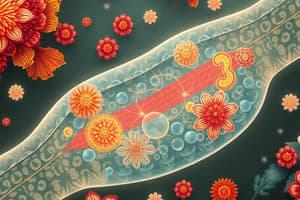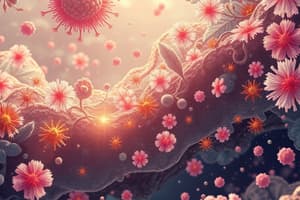Podcast
Questions and Answers
What does diffusion involve in biological systems?
What does diffusion involve in biological systems?
- Random movement of molecules against a concentration gradient
- Movement of molecules from higher to lower concentration (correct)
- Movement of molecules from lower to higher concentration
- Selective absorption of molecules by the cell membrane
What role does the cell membrane play in diffusion?
What role does the cell membrane play in diffusion?
- It is completely impermeable to all substances
- It regulates movement only based on electrical charges
- It facilitates the movement of all molecules without restriction
- It selectively allows certain molecules to pass through (correct)
Which of the following examples illustrates diffusion in living organisms?
Which of the following examples illustrates diffusion in living organisms?
- Water diffusing into cells against the gradient
- Cell waste expelled through vesicular transport
- Nutrients actively transported into cells
- Oxygen moving from lungs to bloodstream (correct)
In the context of plants, when do they require carbon dioxide for photosynthesis?
In the context of plants, when do they require carbon dioxide for photosynthesis?
Which substances are typically obtained by diffusion in the small intestine?
Which substances are typically obtained by diffusion in the small intestine?
What causes plant cells to become turgid?
What causes plant cells to become turgid?
What happens to animal cells placed in a strong sugar solution?
What happens to animal cells placed in a strong sugar solution?
Which of the following describes active transport?
Which of the following describes active transport?
What is the consequence of plant cells becoming flaccid?
What is the consequence of plant cells becoming flaccid?
What role do carrier proteins play in active transport?
What role do carrier proteins play in active transport?
Which process is responsible for water moving out of plant cells when placed in a concentrated solution?
Which process is responsible for water moving out of plant cells when placed in a concentrated solution?
Why do animal cells not have the same ability to support themselves as plant cells?
Why do animal cells not have the same ability to support themselves as plant cells?
What is a possible effect of placing an animal cell in distilled water?
What is a possible effect of placing an animal cell in distilled water?
What is the primary energy source that drives diffusion?
What is the primary energy source that drives diffusion?
What effect does an increased surface area to volume ratio have on diffusion rates?
What effect does an increased surface area to volume ratio have on diffusion rates?
How does temperature influence the rate of diffusion?
How does temperature influence the rate of diffusion?
What occurs when plant tissue is placed in a concentrated salt solution?
What occurs when plant tissue is placed in a concentrated salt solution?
Why is water considered an essential solvent for living organisms?
Why is water considered an essential solvent for living organisms?
Osmosis involves the movement of water from a region of ___ water potential to a region of ___ water potential.
Osmosis involves the movement of water from a region of ___ water potential to a region of ___ water potential.
What is a likely outcome if a plant cell experiences excessive water intake by osmosis?
What is a likely outcome if a plant cell experiences excessive water intake by osmosis?
Which of the following factors does NOT influence the rate of diffusion?
Which of the following factors does NOT influence the rate of diffusion?
In an osmosis experiment, what would be indicated if plant tissue shows no change in mass after being placed in a solution?
In an osmosis experiment, what would be indicated if plant tissue shows no change in mass after being placed in a solution?
What is the role of cell membranes in osmosis?
What is the role of cell membranes in osmosis?
What happens to plant cells when placed in distilled water?
What happens to plant cells when placed in distilled water?
Which type of cell structure is specifically adapted to increase diffusion efficiency in animals?
Which type of cell structure is specifically adapted to increase diffusion efficiency in animals?
What is the reason for using dialysis tubing in osmosis experiments?
What is the reason for using dialysis tubing in osmosis experiments?
Which of the following accurately describes the movement of molecules across membranes?
Which of the following accurately describes the movement of molecules across membranes?
Flashcards
Diffusion
Diffusion
The movement of molecules from an area of high concentration to an area of low concentration.
Concentration Gradient
Concentration Gradient
The difference in concentration of a substance between two areas.
Partially Permeable Membrane
Partially Permeable Membrane
A membrane that allows some substances to pass through easily, but restricts the passage of others.
How Diffusion Helps Living Organisms
How Diffusion Helps Living Organisms
Signup and view all the flashcards
Diffusion in the Small Intestine
Diffusion in the Small Intestine
Signup and view all the flashcards
Osmosis
Osmosis
Signup and view all the flashcards
Turgor Pressure
Turgor Pressure
Signup and view all the flashcards
Plasmolysis
Plasmolysis
Signup and view all the flashcards
Flaccid
Flaccid
Signup and view all the flashcards
Crenated
Crenated
Signup and view all the flashcards
Active Transport
Active Transport
Signup and view all the flashcards
Carrier Proteins
Carrier Proteins
Signup and view all the flashcards
Step 1 of Active Transport
Step 1 of Active Transport
Signup and view all the flashcards
Kinetic energy
Kinetic energy
Signup and view all the flashcards
Surface area to volume ratio
Surface area to volume ratio
Signup and view all the flashcards
Distance in diffusion
Distance in diffusion
Signup and view all the flashcards
Temperature effect on diffusion
Temperature effect on diffusion
Signup and view all the flashcards
Concentration gradient effect on diffusion
Concentration gradient effect on diffusion
Signup and view all the flashcards
Solvent
Solvent
Signup and view all the flashcards
Water potential
Water potential
Signup and view all the flashcards
Turgid cell
Turgid cell
Signup and view all the flashcards
Wilting
Wilting
Signup and view all the flashcards
Dialysis tubing
Dialysis tubing
Signup and view all the flashcards
Wall pressure
Wall pressure
Signup and view all the flashcards




